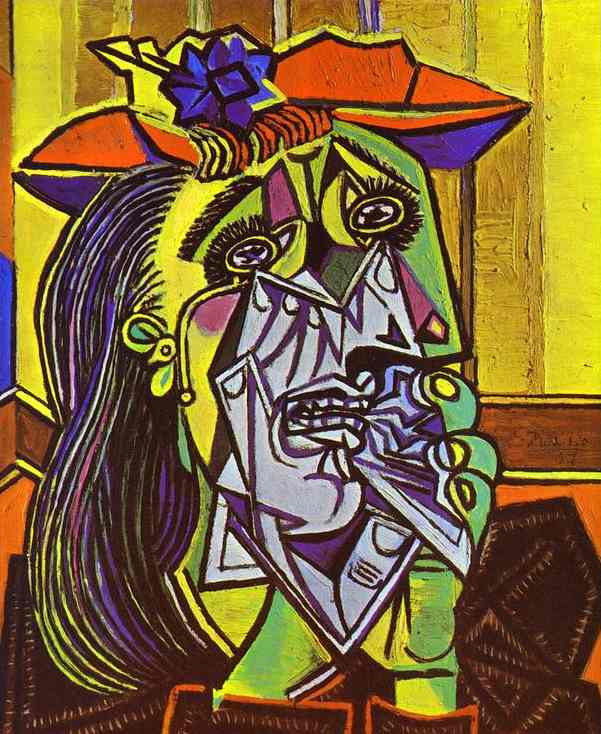Weeping Woman
by Pablo Picasso (1937)

This is a study of how much pain can be communicated by a human face. It has the features of a specific person, Dora Maar, whom Picasso described as "always weeping". She was in fact his close collaborator in the time of his life when he was most involved with politics.
Let your eyes wander over the sharp surface and you are led by the jagged black lines to the picture's centre, her mouth and chin, where the flesh seems to have been peeled away by corrosive tears to reveal hard white bone. The handkerchief she stuffs in her mouth is like a shard of glass. Her eyes are black apertures. When you are inside this picture you are inside pain; it hits you like a punch in the stomach.
Picasso's insistence that we imagine ourselves into the excoriated face of this woman, into her dark eyes, was part of his response to seeing newspaper photographs of the Luftwaffe's bombing of Guernica on behalf of Franco in the Spanish civil war on April 26, 1937. This painting came at the end of the series of paintings, prints and drawings that Picasso made in protest. It has very personal, Spanish sources. In May 1937 Picasso's mother wrote to him from Barcelona that smoke from the burning city during the fighting made her eyes water. The Mater Dolorosa, the weeping Virgin, is a traditional image in Spanish art, often represented in lurid baroque sculptures with glass tears, like the very solid one that flows towards this woman's right ear. Picasso's father, an artist, made one for the family home.
This painting takes such associations and chews them to pulp. It is about the violence that we feel when we look at it, about translating the rawest human emotion into paint. Its origins lie in the tortured figures of Picasso's Guernica (1937), whose suffering is calculated to convey you beyond the photographs of the bombing to sense momentarily what it was to be there. In Guernica there is a screaming woman holding her dead baby, her tongue a dagger pointing at heaven. The baby's face is a cartoon of death. Picasso followed Guernica with his series of Weeping Woman paintings in which the woman's mourning continues, without end. She cries and cries. In different versions the Weeping Woman's face is crushed to an abject lump, twisted out of recognition.
Extract from an article by Jonathan Jones, May 13, 2000, The Guardian
Linked from
:
http://www.inminds.co.uk/end-the-occupation-1-27sep03.html#weepingwoman